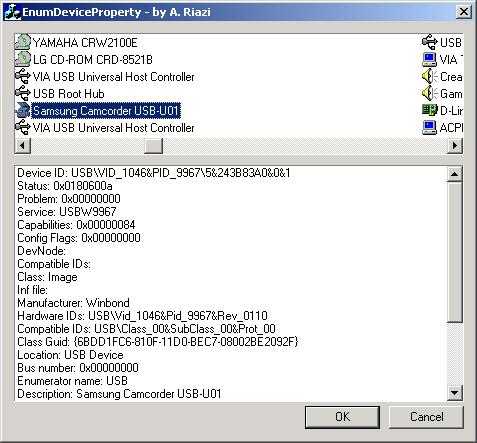
Introduction
In the previous article, I showed you how you can enumerate installed devices. In this article, we want to enumerate properties of an installed device. For this purpose, we use Setup API. You must have the latest platform SDK and also DDK to compile the demo application.
Setup API
The Setup application programming interface (API) provides a set of functions that your setup application can call to perform installation operations or get several information about installed devices, their class, properties and also their GUID (a unique identifier for every device).
The application requires the following APIs (description of these APIs was taken from MSDN):
CMAPI CONFIGRET WINAPI CM_Get_Device_ID_Ex(DEVINST dnDevInst, PTCHAR Buffer,
ULONG BufferLen, ULONG ulFlags, HMACHINE Machine);
The CM_Get_Device_ID_Ex function retrieves the device instance ID for a specified device instance, on a local or remote machine.
CMAPI CONFIGRET WINAPI CM_Get_DevNode_Status_Ex(PULONG pulStatus,
PULONG pulProblemNumber, DEVINST dnDevInst,
ULONG ulFlags, HMACHINE hMachine);
The CM_Get_DevNode_Status_Ex function obtains the status of a device instance from its device node, on a local or a remote machine's device tree.
DWORD CM_Get_DevNode_Registry_Property_Ex(DEVINST dnDevInst, ULONG ulProperty,
PULONG pulRegDataType, PVOID Buffer, PULONG pulLength,
LONG ulFlags, HMACHINE hMachine);
The CM_Get_DevNode_Registry_Property_Ex function retrieves a specified device property from the registry.
Solution
Enumerating properties of an installed device is done by only two functions. The first one specifies the property and then calls the second function. The second function calls CM_Get_DevNode_Registry_Property_Ex function to retrieve property from registry and format it in a good manner.
Here are the two functions:
void EnumDeviceProperties(DEVNODE dn)
{
int BufferSize = MAX_PATH + MAX_DEVICE_ID_LEN;
TCHAR Buffer[MAX_PATH + MAX_DEVICE_ID_LEN];
CString Temp;
DeviceProperties Properties[26]=
{
ID_DEVICEID, _T("Device ID: "), _T(""),
ID_STATUS, _T("Status: "), _T(""),
ID_PROBLEM, _T("Problem: "), _T(""),
ID_SERVICE, _T("Service: "), _T(""),
...
};
if (CM_Get_Device_ID_Ex(dn, Buffer, BufferSize, 0, m_hMachine)
== CR_SUCCESS)
{
Temp=Buffer;
}
else
{
Temp=_T("Fail to retrieve Device ID");
}
ULONG Status, Problem;
if (CM_Get_DevNode_Status_Ex(&Status, &Problem, dn, 0, m_hMachine)
== CR_SUCCESS)
{
Temp.Format(_T("0x%08x"), Status);
Temp.Format(_T("0x%08x"), Problem);
}
else
{
Temp=_T("Fail to retrieve Device Status/Problem");
}
Temp=GetProperty(dn, CM_DRP_SERVICE);
Temp=GetProperty(dn, CM_DRP_CAPABILITIES);
...
}
CString GetProperty(DEVNODE dn, ULONG Property)
{
CString Temp;
TCHAR Buffer[REGSTR_VAL_MAX_HCID_LEN]=_T("");
ULONG Type;
ULONG Size = sizeof(Buffer);
if (CM_Get_DevNode_Registry_Property_Ex(dn, Property,
&Type,
Buffer,
&Size,
0, m_hMachine) == CR_SUCCESS)
{
if (Type == REG_DWORD ||
Type == REG_MULTI_SZ ||
Type == REG_SZ )
{
if (Type == REG_DWORD)
{
DWORD Data = *((DWORD*)Buffer);
wsprintf(Buffer, _T("0x%08x"), *((DWORD*) Buffer) );
}
else if (Type == REG_MULTI_SZ)
{
LPTSTR p = Buffer;
while (_T('\0') != *p)
{
p += lstrlen(p);
if (_T('\0') != *p)
*p++ = _T(',');
}
}
}
}
Temp=Buffer;
return Temp;
}
Enjoy!
